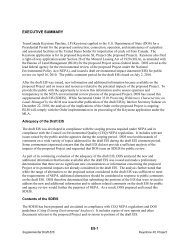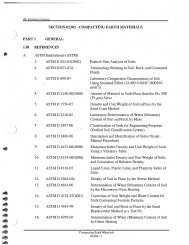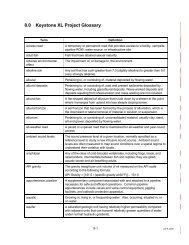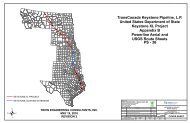2.1 Overview of the Proposed Project - Keystone XL pipeline - US ...
2.1 Overview of the Proposed Project - Keystone XL pipeline - US ...
2.1 Overview of the Proposed Project - Keystone XL pipeline - US ...
Create successful ePaper yourself
Turn your PDF publications into a flip-book with our unique Google optimized e-Paper software.
Draft Supplemental Environmental Impact Statement<strong>Keystone</strong> <strong>XL</strong> <strong>Project</strong><strong>Keystone</strong> would also restrict access to <strong>the</strong> permanent easement using gates, boulders, or o<strong>the</strong>rbarriers to minimize unauthorized access by all-terrain vehicles in wooded areas or o<strong>the</strong>rpreviously unfenced areas if requested by <strong>the</strong> landowner. Pipeline markers would be installed atroad and railroad crossings and o<strong>the</strong>r locations (as required by 49 CFR 195) to show <strong>the</strong> location<strong>of</strong> <strong>the</strong> <strong>pipeline</strong>. Markers would identify <strong>the</strong> owner <strong>of</strong> <strong>the</strong> <strong>pipeline</strong> and convey emergency contactinformation. Special markers providing information and guidance to aerial patrol pilots alsowould be installed. Pipeline markers would be provided for identification <strong>of</strong> <strong>the</strong> <strong>pipeline</strong> locationfor safety purposes in accordance with <strong>the</strong> requirements <strong>of</strong> 49 CFR 195.410 (Line Markers) andPHMSA Special Condition 40 (see Appendix B, PHMSA 57 Special Conditions), including <strong>the</strong>following:• Pipeline markers would be installed on both sides <strong>of</strong> all highways, roads, road ROWs,railroads, and waterbody crossings and in areas where <strong>the</strong> <strong>pipeline</strong> is buried less than48 inches.• Pipeline markers would be made from industrial strength materials to withstand abrasionfrom wind and damage from cattle.• Pipeline markers would be installed at all fences.• Pipeline markers would be installed along <strong>the</strong> ROW to provide line-<strong>of</strong>-sight marking <strong>of</strong> <strong>the</strong><strong>pipeline</strong>, providing it is practical to do so and consistent with <strong>the</strong> type <strong>of</strong> land use, such that itdoes not hinder <strong>the</strong> use <strong>of</strong> <strong>the</strong> property by <strong>the</strong> landowner. Pipeline markers would be installedat all angle points, and at intermediate points, where practical, so that from any marker, <strong>the</strong>adjacent marker in ei<strong>the</strong>r direction would be visible.• Consideration would be given to installing additional markers, except where <strong>the</strong>y wouldinterfere with land use (e.g., farming).• Aerial markers showing identifying numbers would be installed at approximately 5-mileintervals.• At each MLV site and pump station, signs would be installed and maintained on <strong>the</strong>perimeter fence where <strong>the</strong> <strong>pipeline</strong> enters and exits <strong>the</strong> fenced area.Markers would identify <strong>the</strong> owner <strong>of</strong> <strong>the</strong> <strong>pipeline</strong> and convey emergency contact information.Special markers providing information and guidance to aerial patrol pilots also would beinstalled. The markers would be maintained during <strong>the</strong> operating life <strong>of</strong> <strong>the</strong> proposed <strong>Project</strong>.Post-construction Reclamation Monitoring and ResponseThe ROW would be inspected after <strong>the</strong> first growing season to determine <strong>the</strong> success <strong>of</strong>revegetation and noxious weed control. Eroded areas would be repaired and areas that wereunsuccessfully re-established would be revegetated by <strong>Keystone</strong> or <strong>Keystone</strong> would compensate<strong>the</strong> landowner for reseeding. The CMRP (Appendix G) provides information on revegetation andweed control procedures that <strong>Keystone</strong> would incorporate into <strong>the</strong> proposed <strong>Project</strong>.<strong>2.1</strong>.8 Special Pipeline Construction ProceduresSpecial construction techniques would be used when crossing roads, highways, and railroads;<strong>pipeline</strong>, utility, and o<strong>the</strong>r buried feature crossings; steep terrain; unstable soils; perennialwaterbodies; wetlands; areas that require ripping; and residential and commercial areas. These<strong>Project</strong> Description <strong>2.1</strong>-50 March 2013











